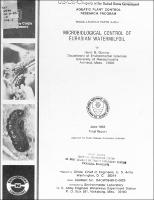Please use this identifier to cite or link to this item:
https://hdl.handle.net/11681/6267| Title: | Microbiological control of Eurasian watermilfoil |
| Authors: | Gunner, Haim B., 1924- |
| Keywords: | Aquatic plant control Aquatic plants Aquatic weeds Biological control Biocontrol Microorganisms Eurasian watermilfoil Myriophyllum spicatum Aquatic Plant Control Research Program (U.S.) |
| Publisher: | U.S. Army Engineer Waterways Experiment Station |
| Series/Report no.: | Miscellaneous Paper (Aquatic Plant Control Research Program (U.S.)) ; no.Miscellaneous Paper A-83-4 |
| Abstract: | Cellulolytic and pectinolytic microorganisms were isolated from the microbial populations naturally resident in the phyllosphere of Eurasian watermilfoil, Myriophyllum spicatum and of M. heterophyllum. The yield of their respective operative enzymes was maximized by growth in appropriate cellulose and pectin media; the organisms, when subsequently applied to the plants, accelerated the plants' necrosis and decline. That cellulose and pectin are particularly vulnerable target tissues in Myriophyllum spp. was confirmed by the significant increase in plant necrosis achieved over untreated controls by the simple addition of sterile cellulose and pectin media to respective test chambers. Presumably this reflected the selective stimulus provided by these substrates to the resident cellulolytic and pectinolytic microflora. A consortium of cyanobacteria associated with Myriophyllum was also found to accelerate necrosis, as did its sterile growth medium; again, presumably, as a reflection of the selective stimulus provided to the cyanobacteria in the phyllosphere. The species determination of phyllosphere residents was reflected in the significantly higher pathogenic potential of the isolates from M. spicatum to that species than to M. heterophyllum. The results suggest that microorganisms native to the Myriophyllum ecosystem, particularly those selected for their ability to attack specific plant tissues or, alternatively, amendments applied to the environment stimulating the growth of such populations, offer promising avenues for the biological control of these aquatic nuisance plants. |
| Description: | Miscellaneous Paper |
| Gov't Doc #: | Miscellaneous Paper A-83-4 |
| Rights: | Approved for public release; distribution is unlimited |
| URI: | http://hdl.handle.net/11681/6267 |
| Appears in Collections: | Miscellaneous Paper |
Files in This Item:
| File | Description | Size | Format | |
|---|---|---|---|---|
| MP-A-83-4.pdf | Miscellaneous Paper A-83-4 | 4.38 MB | Adobe PDF |  View/Open |